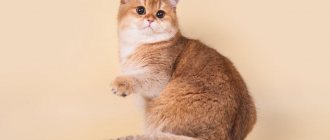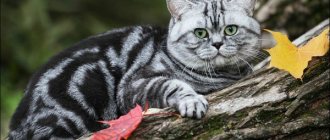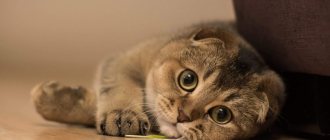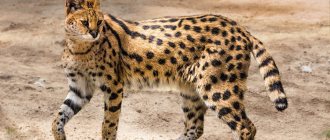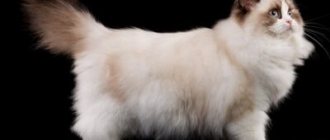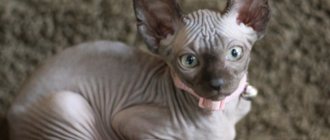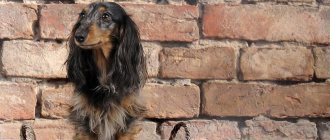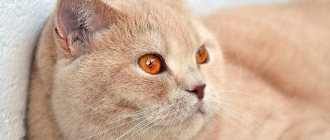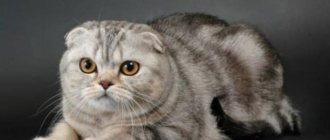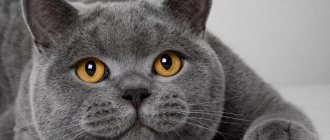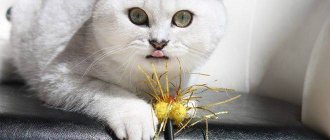Scottish cat breeds are divided into several varieties, which have both common features and differences. If you believed there was only one variety Scottish cat, then this is not so: you can become the owner of a Scottish fold shorthair cat called Scottish Fold, place a Scottish straight shorthaired beauty called Scottish Straight in your home, or bring a longhaired Highland Fold into your family. There is only one species left to choose from: the Highland Straight - also a Scottish breed, but straight-eared and long-haired.
These cats are loved not only for their elegant exterior, but also for their interesting character traits. Let us add that the character traits will be equally suitable for all Scots; the types differ only in external beauty.
History of the Scottish Straight cat breed
Scottish Straight cat
Scottish Straight are the same Scottish folds, but with a modified position of the ear. Straight ears do not have a characteristic crease and are set straight, and this, in fact, is the only external sign that distinguishes them from their fold-eared counterparts. Scottish cats are considered one of the youngest cat breeds. The first cat with an unusual, flattened ear shape appeared on a Scottish farm in the early 60s. Surprisingly, the ancestor of modern folds and straights had no pedigree and simply chased mice through the barns of local peasants.
The first official Scottish breeder was an ordinary villager, William Ross, who adopted a kitten from the aforementioned Fold. A few years later, professional breeders also joined the process. At the same time, experts witnessed an interesting phenomenon: in the litters brought by even the most purebred Scottish dogs, babies with erect ears appeared. Of course, no one intended to separate such individuals into a separate breed. And kilometer-long queues did not line up for straight-eared kittens, because against the backdrop of touching folds, they were outright losing. But here nature itself intervened.
Very soon, Scottish breeders noticed that attempts to strengthen and strengthen the lop ears of animals had a negative impact on their health. The mutated gene responsible for the flatness of the ear folds began to inhibit the function of the skeletal apparatus of cats. As a result, the Scots began to suffer from thickening of the bones and osteochondrodysplasia. To keep the breed afloat, breeders rushed to look for “new blood” that would help the Scottish survive and reduce the number of their genetic defects. Through trial, error and outcrossing, it was discovered that the healthiest and most beautiful offspring can be obtained from crossing a Fold cat and a straight-eared male of the same breed. It was thanks to this discovery that breeders and felinological associations finally turned their attention to straight-eared Scots. Well, in 2004, the Scottish Straight subspecies received official recognition from the World Cat Federation and the status of an independent breed, which sharply increased the attractiveness of straight-eared cats in the eyes of potential buyers.
Highland fold
The most interesting looking Scots are Highland Fold cats. These animals brought together all the characteristics of the breed, combining folding ears and luxurious long hair. The pubescent head looks as if it is completely devoid of ears.
Highland Fold kittens can be born even from two cats with short hair, since the gene for long hair is recessive. Thus, obtaining a kitten with both matching characteristics in the offspring has a low probability. Only careful, competent selection work allows unique kittens to be born.
The Scots differ from the Persian cat in the length and density of their hairs. A coat with a silky structure is easier to comb out, and the Highland Fold sheds much less. Loose, cotton-like fur in Scottish cats is considered an important defect.
Specifics of the Highland Fold
It is important that fold-eared kittens of any length of hair have one straight-eared parent. Otherwise, there is a high probability of inheriting diseases such as:
- polyarthritis;
- osteochondrodysplasia;
- vertebral fusion;
- ossification of cartilage.
In addition, the coat of Highland Fold cats requires more care than the short-haired type.
Appearance of the Scottish Straight
Scottish Straights can easily be confused with the British, although representatives of these two breeds have a minimum of common genes. Scottish Straight cats are much smaller than their competitors from Albion, although they have a longer body. The weight of an average straight is 3-3.5 kg. Modern breeders are still wondering what kind of offspring they will get after mating a fold and a straight, since initially all kittens are born with ordinary ears, which change their position only at the end of the first month of life.
Head
Mustachioed Scotsman
According to the WCF standard, Scottish Straights must have a rounded skull. Representatives of this breed have convex foreheads and cheeks. In cats, the area of the cheekbones and cheeks is noticeably more rounded than in cats. The chin of the Scots is firm, rounded, but does not protrude forward. The whisker pads are distinguished by their characteristic “swelling” and have the shape of a regular oval.
Nose
Wide and short, with a slight arch of the back and a pronounced base, practically without a stop.
Eyes
Large and round, widely spaced. The gaze is open, inquisitively focused. Eye color depends on the coat color of the animal.
Ears
Erect, small, with a wide base. The tips of the ears are rounded and point forward. The outer part of the ear is covered with thick, close-fitting hair. The inner part is decorated with lush and stiff hair brushes extending beyond the edge of the ear.
Neck
The Scottish Straight cat has a muscular and short neck.
Scottish Straight muzzle
Frame
Moderately long, muscular and wide, tending to the rectangular type. The silhouette line is soft and rounded.
Limbs
Proportional to the body, that is, moderately long and strong, with developed muscles. The paws are oval, the toes are tightly clenched.
Tail
Medium or long, mobile, reaching to the middle of the shoulder blades.
Wool
Scottish Straight tabby color
Short or semi-long (in Highland individuals). Double, plush type, with well-developed undercoat. It does not adhere to the body, but covers it tightly. The texture of the coat may vary slightly depending on the season, as well as the type of color of the animal.
Color
The standard allows all types of colors found among representatives of this breed. The most typical color options for Scottish Straight cats are solid, bicolor, point, tabby, particolor, chinchilla, ticked, van and shedded.
Defects in appearance and disqualifying defects
Individuals with semi-erect or too wide ears with a British set are considered not the most successful representatives of their breed. The flat forehead, pronounced stop, long legs and small eyes of the Scottish Straight are also not decorative. Animals with an insufficiently long, inactive and kinked tail, cryptorchidism and everted toes are subject to unconditional disqualification. Weak and sick cats are also not allowed to participate in exhibition events.
Kittens from a Scottish Fold cat, with an average of five straight-eared and one fold-eared
Colors
Felinologists identify the basic colors of the Scottish Straight cat:
- black;
- blue;
- chocolate;
- lilac;
- cinnamon (milk chocolate);
- fawn (light cinnamon);
- cream;
- red.
The main background may contain various patterns: brindle, spotted, marble. In addition, there are variations with white colors: medallion, bicolor, harlequin, van, exclusively white. Cats of colors with silver look great: smoky or silver drawn, shaded, chinchilla.
There are a group of golden colors: ticked, shaded, golden chinchilla. There are also straight point colors with all sorts of variations in shades and patterns.
The group of tortoiseshell Scots is not inferior in number. Often there are cats of patchwork, solid, painted colors, as well as calico.
Plain (solid)
Solid colors are characterized by monotony. There are no patterns, markings or ticking on the coat.
Varieties:
- Dazzling white. The iris is amber, blue. The nose and paw pads are pink.
- Pure black. The iris is amber, the nose and paws are dark, blending in with the fur.
- Blue with dark gray edge. Amber iris. The nose and paws are gray.
- Lilac - the coat is light gray, transitioning to cream. Amber iris. The nose and paws match the color.
- Red with a fiery edge. The iris is amber, the nose and paws are the same color as the fur.
- Cream - light peach colored coat. The iris is golden. The nose and paw pads are pink.
- Cinnamon is a cinnamon color, reminiscent of milk chocolate. The nose and paw pads are pink-brown.
Bicolors (two-color)
Varieties:
- Bicolor is a combination of basic white with blue, black, cream, and red. The muzzle, belly, legs and thighs are light, without inclusions. Eyes are golden or blue. Heterochromia - different colored eyes - is also common.
- Van - the main color is white, but there are dark markings on the tail and head. The iris is golden or blue. Heterochromia is characteristic.
- Harlequin has a white edge and only 1/5 of the fur is colored.
Color point
There are no patterns on the body, which is why it contrasts with dark blotches on the muzzle, paws and tail.
Varieties:
- blue point (white with light blue);
- seal point (cream with dark brown);
- lilac point (white with lilac);
- Choclet point (white with brown);
- cream point (light cream with cream);
- tortoiseshell with red or cream spots;
- tabby point (striped pattern).
Reference. Pointed cats are born with a gene that causes hairs on parts of the body such as the face, paws, tail and ears to darken when body temperature is low. In these places there is weaker blood circulation, which is why the color is darker.
Scots have a color-point sky blue iris.
Tortoiseshells
There are fire and peach markings on a mostly black background. The iris is copper. The nose and paws are pink or black.
Smoky
Representatives of the smoky color have a white undercoat. The iris is golden.
Varieties:
- Black. The tips of the hairs are black, the bulbs are white. The nose and pads match the color.
- Blue. White undercoat, edge with a coolish gray coating. The nose and paws are in the same color scheme.
- Cameo. Snow-white undercoat, guard hairs with a fiery tint. The nose, paws and eyeliner are pink.
Tabby
Representatives of the tabby breed have a distinctive feature - a mark on the forehead in the shape of the letter M. There are narrow stripes on the tail and limbs, smoothly turning into marble patterns and narrow stripes on the neck and body of the animal. The drawing is bright and contrasting. The eyes and nose are lined dark.
Varieties:
- Striped or brindle - a clear pattern of narrow stripes. There is a pattern on the neck in the form of a collar, the tail is striped. There are stripes across the body, along the back line, in the withers area, which are combined into a pattern reminiscent of a saddle.
- Spotted tabby - marks of different shapes and sizes with clear contours are visible on the body. Along the spine, the spots merge into a line that stretches from head to tail. The belly is painted with small spots.
- Classic tabby or marbled - the body is covered with irregularly shaped patterns of various colors, reminiscent of stains on marble.
- Fire tabby (fawn or red) - a bright red, clear pattern of spots and stripes on a light background is visible on the body. The eyes are golden, the nose is pink-orange, and the paw pads are brick-colored.
- Blue tabby - a clear pattern of dark spots and stripes is visible on a cool gray background. The iris is golden or sky blue. The nose and paw pads are pink.
- Brown tabby - black patterns on a beige background. The eyes and nose are dark in color, the pads are dark beige, almost black.
- Cream tabby - dark, slightly blurry patterns of streaks and stripes are visible on a light peach coat. The eyes are golden, the nose and paw pads are pink.
- Silver tabby - on a silver background you can see a black pattern of stripes turning into spots. The iris is light beige or green. The nose is pink-beige, the pads are dark.
Chinchilla
Varieties:
- Silver - white undercoat, guard hairs covered with gray. There may be blurry stripes on the tail. The tips of the ears, chin and belly are white. The iris is green, the nose is beige. The eyes, nose and lips are lined in black. The paw pads are also black.
- Red or Shell Cameo - snow-white undercoat, the fur on the body and paws is tucked in red, the chin, tips of the ears and belly are white. The iris is golden, the nose is brick-colored, and the paw pads are pink.
ticked
Ticking cats have hairs that are unevenly colored in three colors. On each hair, zones of different colors alternate across in the form of rings without traces of a pattern. This way unique shades are created. It seems that the wool shimmers in different colors. The iris is of all shades of gold; in cats with silver ticking it is green.
Shaded
Such cats have an almost white undercoat, and the tips are whitish. The edge is trimmed in any color, the chin and belly are always light.
Varieties:
- Golden - Light peach goes well with golden fur. The iris is green, the paw pads and nose are dark chocolate.
- Silver - snow-white undercoat, the tips of the hairs are dark gray. The eyes are green and lined with black. The nose is brick, the pads are dark.
- Red or cameo - the undercoat is white, the tips of the hairs are dark red. The muzzle and chin, belly and underside of the tail are light. Amber iris. The nose, eyeliner and paw pads are pink.
Scottish Straight character
It would be a big mistake to label all Scottish Straights as phlegmatic philosophers. Moreover, among these imposing cats, sometimes there are real livelies who love to chase a wind-up mouse and measure their strength with the owner. And yet, for the most part, Scottish straight cats do not have a violent temperament. Proud and serious, they cannot stand total control and are unlikely to allow themselves to be squeezed into a semi-conscious state. This, of course, does not make Scottish ascetics and sad hermits, they just require a little more independence and personal space than representatives of other breeds. Straights prefer to spend their free time in peace and quiet, lounging on the couch and learning Zen in the Buddha pose.
Squeezing the cat
The Scots are happy to make contact and join in the games, but only when they want to. In all other cases, it is better to leave the cat alone. The peak of motor activity of straight-eared Scottish cats occurs in the first year of their life. By the way, Scottish babies in their playfulness and restlessness are practically no different from ordinary outbred kittens. Adults, on the contrary, are famous for their exemplary behavior and patience. If you go on a visit for a couple of hours, leaving the Straight alone, he will easily survive it. However, weeks of loneliness, interrupted by rare raids from the owner, will not improve the character of the animal. As for the pacifying purr of straight-eared Scottish cats, it still needs to be earned: cats purr infrequently, and meow only in exceptional, from their own point of view, cases. Scottish Straights accept strangers and noisy groups of guests in a completely “secular” way, which means without unnecessary suspicion and aggression, but also without wild delight.
Scottish Straight cats are emotionally stable and not subject to sudden mood swings. However, exceptions to the general rule have not been canceled, so amateur videos with catchy headlines like: “The most disgruntled Scottish in the world” periodically appear on the Internet. In addition, straights are characterized by amazing persistence. If a cat wants something, he will definitely achieve it, following on the heels of the owner, and sometimes reinforcing his actions with annoying meows.
Sharpen your claws only on a scratching post
Claws are an important attribute of any cat. With their help, the animal climbs trees and other surfaces, and also uses them as a means of defense. Sharpening claws, doing a kind of manicure, is a natural need for a pet. Unknowingly, cats begin to tear up everything that gets in their way: furniture, carpets, wallpaper. To avoid this, you need to accustom your pet to order. Every time a cat starts sharpening its claws in an inappropriate place, immediately pick up the animal and bring it to the scratching post. This needs to be repeated several times. Gradually, the animal learns to sharpen its claws where it is needed.
Training and education
Scottish Straight
Intelligent by nature, Scottish Straight cats are easy to educate and very difficult to fully train. Teaching a Straight to use a litter box and a scratching post is not at all difficult, provided that this process was started in time, before your pet matures. By the way, young Scottish cats are active and sometimes uncontrollable, so in the first months of the baby’s life you will have to put up with the inevitable destruction in the house.
Even if the fame of Yuri Kuklachev haunts you, it’s better not to get carried away with the serious drill of straights. Whatever the experts say, unquestioning obedience to commands is not the strong point of Scottish straight-eared cats. Instill in your pet the basics of etiquette and teach him to respect subordination - this will be quite enough. As for a full-fledged training program, save it for show-class individuals, who will later have to demonstrate their talents at exhibitions.
- If the animal allows itself too much, try to stop it with the command “No!”, which is given in a stern and loud voice.
- If the kitten does not respond to a stern tone, grab it by the scruff of the neck and imitate a cat hissing. The baby will understand this language faster.
- Do not try to poke the kitten's muzzle into the puddle it has made or try to hammer the basics of cleanliness into it with a slipper. After suffering stress, the cat will definitely play a mischief in another place, but this time it will be reliably hidden from you.
- Have you noticed that your plush beast is sitting in an unambiguous position on the carpet or trying to steal food from the table? Scare him with a loud whistle or clap of your hands. Make no mistake, fear is a very powerful educational tool.
- Never scold or praise a Scottish Straight cat after the fact. Despite a fairly high level of intelligence, the animal is not able to connect together yesterday's exemplary behavior and today's reward.
Care and maintenance
Scottish Straights are typical domestic cats for whom walks in the fresh air are pleasant entertainment, but not more than that. This is why Scots are considered ideal pets for homebodies. In everyday life, straights are unpretentious and rarely cause trouble. Take your animal for routine veterinary examinations, carry out timely vaccinations, use high-quality food - and straight-eared Scottish cats will not create any problems for you.
Hygiene
Scottish Straight loves his mistress
Scottish Straights are very clean cats that carefully monitor the condition of their own fur, but they still need to be bathed from time to time. Usually, cats are washed as their “coat” gets dirty, using shampoo from the pharmacy. At the end of the procedure, you can apply a balm to the coat. When bathing, make sure that water does not get into the animal’s ears and be sure to protect the wet pet from drafts.
Owners of show-class specimens preparing to participate in exhibitions will have to work a little harder. In particular, a few months before the event, the cat begins to be washed daily to completely remove dead cells from its skin and stimulate the growth of new fur. In addition, you will have to spend money on a variety of professional coat care products, ranging from degreasing paste to texturizing conditioner. Brush Scottish cats once a week with a short hair brush. Claws are trimmed as they grow. Be sure to monitor the condition of your cat's eyes and remove unwanted discharge with a swab soaked in hygiene lotion.
Feeding
The diet of Scottish Straights is no different from the “menu” of their fold-eared counterparts. Just like folds, Scottish straight-eared cats benefit from lean meat, offal, boiled sea fish, fermented milk products, and egg yolk. In addition, the animal’s diet should include vegetables (raw or stewed), cereals and sprouted wheat.
Prohibited
- Fat meat.
- Beans and potatoes.
- Bones.
- Sweets, spices, smoked foods.
- Garlic and onion.
- Bread.
- River fish.
- Citrus.
- Mushrooms.
- Raw eggs.
Curious Scottish Straight
In serious nurseries, Scottish Straight kittens are sold starting from the age of three months. During this period of life, the baby no longer feeds on mother's milk, which means it is able to eat the same food as an adult animal.
An important point: natural-fed straight cats do not receive enough of the vital microelements. Vitamin and mineral complexes, which can be purchased at a veterinary pharmacy, solve this problem.
Scottish Fold cats can also be fed commercial food if you are willing to spend money on its non-budget varieties - “premium”, “super premium” and “holistic”. An ideal cut for a Scottish dog should contain at least 26% protein and about 9% fat. It is advisable that the food does not contain wheat and corn, which can cause allergies in the cat. From this point of view, the most useful options for “drying” can be considered the Canadian Acana Pacifica Cat and the American Earthborn Holistic.
Three-month-old Scots are fed up to 6 times a day, six-month-old kittens eat 5 times a day, nine-month-old kittens - 4 times. One-year-old individuals are considered adults, so 2-3 meals are enough for them.
Breeding
Sexual maturity in Scottish beauties occurs at 8-10 months, but the first mating is carried out no earlier than 1.3 years. Early mating often results in protracted labor and death of the offspring, and in males it leads to a shortening of the fertile period.
The first heat of cats occurs after a year. She needs to be passed and mated for the second or third heat.
The intervals between estrus vary and depend on the season. Breeders have noticed that purebred cats have much fewer periods of heat throughout the year than domestic cats.
The breeding partner must be selected in advance, following the rules established by the WCF. Ideally, the cat should be the same color as the female cat. It is not recommended to mix chinchilla with tabby, blue with lilac, etc. From such unions, kittens are born with uneven color or an indeterminate iris color.
Folds are mated exclusively with straights! The cat is brought into the cat's territory on the second day of estrus. First, the couple gets acquainted, the male courtes his lady with all his might, and the female explores the territory. The success of mating largely depends on the cat. Some very impressionable “grooms” are at a loss from the “bride’s” aggression, others do not even blink in response to the evil hiss.
The couples meet in a civilized manner. For some time, it is better to keep the animals on opposite sides of the door. This way they will receive information in doses. As soon as the partners get to know each other, the barrier between them can be removed. The duration of the mating itself should not exceed three days. Pregnancy lasts 9 weeks. After mating, the female becomes very calm.
The first signs of pregnancy appear after 2-3 weeks: the nipples turn pink and swell. At week 5, the belly is rounded and weight gain is observed. You need to prepare for childbirth in advance: buy disposable diapers, scissors for cutting the umbilical cord, disinfectants. You can also schedule the birth with your veterinarian, especially if your cat is giving birth for the first time.
Health and disease of the Scottish Straight cat
Scots live up to 15-20 years of age without much difficulty, but only if they were properly cared for and mandatory veterinary procedures were not neglected. Unlike folds, straights have practically no genetic mutations or hereditary diseases, so representatives of this breed are relatively healthy animals with good immunity. As for diseases of the gastrointestinal tract and genitourinary system, sometimes diagnosed in straight-eared Scottish cats, they are most often caused by poor nutrition.
What do the Scots get sick of?
Like most animals, Scots tend to get sick, so regular examination by a veterinarian will certainly not harm them. Diseases specific to this breed include joint pathologies. Osteochondrodysplasia is the destruction of articular cartilage, an incurable and irreversible process. At the same time, the animal is limping, its movements are stiff, and movement is difficult.
In addition to joint problems, Scots are prone to obesity, and, as a result, heart problems. Cardiomyopathy, a disease accompanied by heart failure.
If an animal is fed dry food, there is a high risk of developing urolithiasis. In addition to the listed diseases, Scots often suffer from eye and skin diseases.
In all cases, it is strictly forbidden to self-medicate. The animal must be urgently shown to a specialist who will make a diagnosis and prescribe treatment.
How to choose a Scottish Straight kitten
Arm yourself with the breed standard and visit a Scottish Straight breeder in an informal setting to see with your own eyes the conditions in which the kittens grow up. Well-groomed Scottish dogs have lush, shiny coats and clear, open eyes. The abdomen of a normally developing baby is soft, and not swollen to the point of a ball. A healthy kitten's tail should be clean, and its fur should not smell bad or sparkle with bald spots.
Observe the behavior of the young Scottish Straight. A trouble-free baby willingly joins in the gameplay and shows interest. Kittens that are bored and unresponsive are most likely unhealthy or depressed. Observing the character of the babies’ parents is also a good safety net, since it is from them that the animals inherit their temperamental characteristics.
Weight table by month
The Scottish Straight weight gain graph is clearly demonstrated in the table by month.
| Age | Female (weight in kilograms) | Male |
| 1 month | 0.3-0.65 g | 0.45-0.75 g |
| 2 | 0.45-0.8 g | 0.8-1.6 |
| 3 | 1.25-1.7 | 1.3-2.4 |
| 4 | 1.7-2.35 | 2.1-3.8 |
| 5 | 2.25-3.1 | 2.45-4.2 |
| 6 | 2.3-3.5 | 3.1-5.5 |
| 8 | 2.9-4.3 | 3.4-6 |
| 10 | 3.1-4.6 | 4.2-7.2 |
| 1 year | 3.2-5.3 | 4.6-7.4 |
| 2 and older | 3.4-5.6 | 5.3-8.2 |
